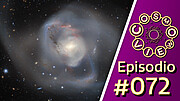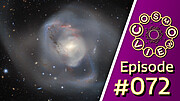GW190425 : Artist's impression of the binary neutron star merger observed by LIGO Livingston on April 25, 2019. Image credit: National Science FounGW190425 : Artist's impression of the binary neutron star merger observed by LIGO Livingston on April 25, 2019. Image credit: National Science Foundation/LIGO/Sonoma State University/A. Simonnet. dation/LIGO/Sonoma State University/A. Simonnet.
On April 25, 2019, the LIGO Livingston Observatory picked up what appeared to be gravitational ripples from a collision of two neutron stars. LIGO Livingston is part of a gravitational-wave network that includes LIGO (the Laser Interferometer Gravitational-wave Observatory), funded by the National Science Foundation (NSF), and the European Virgo detector. Now, a new study confirms that this event was indeed likely the result of a merger of two neutron stars. This would be only the second time this type of event has ever been observed in gravitational waves.
The
first such observation, which took place in August of 2017, made history as the first joint observation of the same cosmic event in both gravitational waves and light. The April 25 merger, by contrast, did not result in any light being detected. However, through an analysis of the gravitational-wave data alone, researchers have learned that the objects involved in this collision were unusually massive given the expectations for neutron star binaries.
"From conventional observations with light, we already knew of 17 binary neutron star systems in our own galaxy and we have estimated the masses of these stars", says Ben Farr, a LIGO team member based at the University of Oregon. "What's surprising is that the combined mass of this binary is much higher than what was expected."
"We have detected a second event consistent with a binary neutron star system and this is an important confirmation of the August 2017 event that marked an exciting new beginning for multi-messenger astronomy two years ago", says Jo van den Brand, Virgo Spokesperson and professor at Maastricht University, and Nikhef and VU University Amsterdam in the Netherlands. Multi-messenger astronomy occurs when different types of signals are witnessed simultaneously, such as those based on gravitational waves and light.
The study, accepted for publication in The Astrophysical Journal Letters, is authored by an international team comprised of the LIGO Scientific Collaboration and the Virgo Collaboration, the latter of which is associated with the Virgo gravitational-wave detector in Italy.
Neutron stars are the remnants of dying stars that undergo catastrophic explosions as they collapse at the end of their lives. When two neutron stars spiral together, they undergo a violent merger that sends gravitational shudders through the fabric of space and time.
LIGO became the first observatory to directly detect gravitational waves in 2015; in that instance, the waves were generated by the violent collision of two black holes. Since then, LIGO and Virgo have registered dozens of additional candidate black hole mergers.
“Just as the first gravitational wave detection revealed a binary of unexpectedly massive black holes, this detection again reveals an unexpected member of the ‘cosmological ecosystem’ ”, says
Nathan Johnson-McDaniel from the Department of Applied Mathematics and Theoretical Physics (DAMTP) at the University of Cambridge. “It is yet another illustration of the great discovery potential of gravitational wave observations.”
GW190425 FactSheet
The April 2019 event was first identified in data from the LIGO Livingston detector alone. The LIGO Hanford detector was temporarily offline at the time, and, at a distance of more than 500 million light-years, the event was extremely faint in Virgo's data. Using the Livingston data, combined with information derived from Virgo’s data, the team narrowed the location of the event to a patch of sky more than 8,200 square degrees in size, or about 20 percent of the sky. For comparison, the August 2017 event was narrowed to a region of just 16 square degrees, or 0.04 percent of the sky.
“But what was the fate of this merger, what type of remnant did it leave behind?”, wonders
Michalis Agathos, researcher at DAMTP and the Kavli Institute for Cosmology in Cambridge. “To answer this we can make use of information on the properties of neutron-star matter, that we had gained from the first event back in 2017. And we infer that the binary of this second event seems to be massive enough to immediately collapse upon merger, forming a black hole. Hence we should not expect a strong electromagnetic afterglow.”
The LIGO data reveal that the combined mass of the merged bodies is about 3.4 times the mass of our Sun. In our galaxy, known binary neutron star systems have combined masses up to only 2.9 times that of the Sun. One possibility for the unusually high mass is that the collision took place not between two neutron stars, but a neutron star and a black hole (black holes can be heavier than neutron stars). In this case, however, the black hole would be too light to match astrophysical observations and theoretical expectations. Therefore, the scientists believe it is much more likely that LIGO witnessed a merger of two neutron stars.
“When you look at the black holes and neutron stars observed so far, however, there is a gap in their mass distributions”, says
Ulrich Sperhake head of the Cambridge LIGO group at DAMTP. “You have the black holes on the heavy end, the neutron stars on the light end and seemingly no objects in between with about 2.5 to 5 solar masses. This detection may give us the first clues whether and how this gap is filled.”
“This second event was consistent with matter properties extracted from the first binary neutron star observation, GW170817, but was not as loud”, said
Charalampos Markakis from the University of Cambridge. “Future events and detector upgrades will allow us to measure properties of matter at extreme densities, beyond the reach of terrestrial laboratories, expanding our understanding of high-energy physics.”
Neutron star pairs are thought to form in two possible ways. They might form from binary systems of massive stars that each end their lives as neutron stars, or they might arise when two separately formed neutron stars come together within a dense stellar environment. The LIGO data for the April 25 event do not indicate which of these scenarios is more likely, but they do suggest that more data and new models are needed to explain the merger’s unexpectedly high mass.
Additional information about the gravitational-wave observatories:
LIGO is funded by the NSF and operated by Caltech and MIT, which conceived of LIGO and lead the project. Financial support for the Advanced LIGO project was led by the NSF with Germany (Max Planck Society), the U.K. (Science and Technology Facilities Council) and Australia (Australian Research Council-OzGrav) making significant commitments and contributions to the project. Approximately 1,300 scientists from around the world participate in the effort through the LIGO Scientific Collaboration, which includes the GEO Collaboration. A list of additional partners is available at https://my.ligo.org/census.php.
The Virgo Collaboration is currently composed of approximately 520 members from 99 institutes in 11 different countries including Belgium, France, Germany, Hungary, Italy, the Netherlands, Poland, and Spain. The European Gravitational Observatory (EGO) hosts the Virgo detector near Pisa in Italy, and is funded by Centre National de la Recherche Scientifique (CNRS) in France, the Istituto Nazionale di Fisica Nucleare (INFN) in Italy, and Nikhef in the Netherlands. A list of the Virgo Collaboration groups can be found at http://public.virgo-gw.eu/the-virgo-collaboration/. More information is available on the Virgo website at http://www.virgo-gw.eu.





























